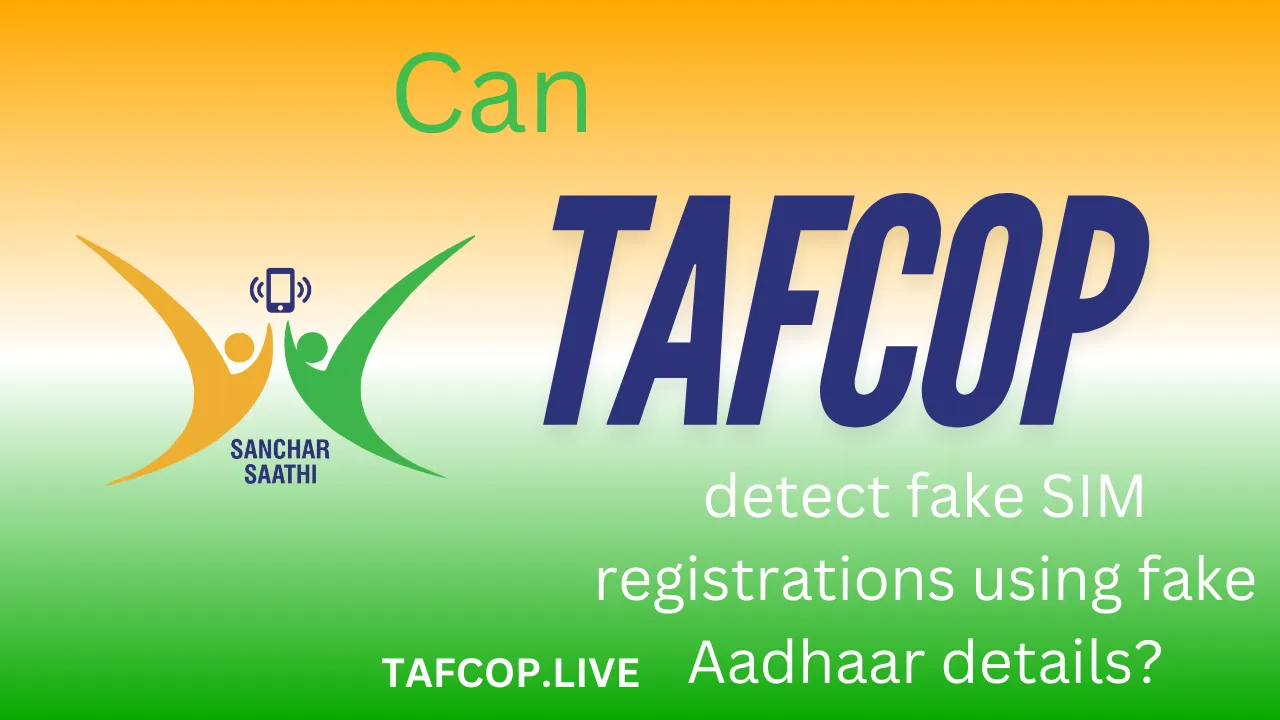Imagine waking up one day to find multiple SIM cards registered under your name—ones you never applied for! Sounds scary, right? Telecom fraud is a growing menace in India, and fraudulent SIM registrations using fake Aadhaar details are a major part of it. But there’s good news: the TAFCOP (Telecom Analytics for Fraud Management and Consumer Protection) portal is here to tackle this problem head-on.
Can TAFCOP detect fake SIM registrations using fake Aadhaar details?(Quick Answer)
Yes, TAFCOP can detect fake SIM registrations using fake Aadhaar details by cross-verifying telecom data with Aadhaar-linked information, identifying inconsistencies, and alerting authorities to prevent fraudulent activities.
How does TAFCOP verify Aadhaar details for SIM registration?
TAFCOP works by analyzing telecom records and linking them to Aadhaar-based eKYC (electronic Know Your Customer) data. When a SIM card is registered, the system checks if the Aadhaar details match the official database.
For example, if someone attempts to use a forged or tampered Aadhaar card, TAFCOP flags inconsistencies by comparing the details with UIDAI’s official Aadhaar records. If discrepancies arise, the system notifies telecom operators and regulatory authorities to take immediate action.
What happens when TAFCOP detects a fake SIM registration?
When TAFCOP identifies a suspicious or fake SIM registration, it triggers the following actions:
- Immediate Flagging: The system flags the fraudulent number for investigation.
- User Notification: The actual Aadhaar holder may receive an alert about unauthorized SIM registrations under their name.
- Telecom Operator Review: The concerned telecom provider is notified to verify the legitimacy of the connection.
- Potential Deactivation: If proven fraudulent, the SIM is blocked, and the matter may be reported to authorities.
For instance, if a fraudster registers a SIM using a manipulated Aadhaar, TAFCOP will identify the anomalies in the document’s digital signature or mismatched details and stop the fraud in its tracks.
Can fraudsters bypass TAFCOP using advanced forgery techniques?
While fraudsters always look for loopholes, TAFCOP’s AI-driven analytics make it difficult for them to succeed. The system employs:
- Pattern Recognition to detect unusual activity, such as multiple SIMs linked to a single Aadhaar.
- Biometric Validation in cases where telecom providers conduct fingerprint or iris-based KYC.
- Data Cross-Verification with government databases to check for irregularities in Aadhaar credentials.
However, no system is foolproof. If a fraudster manages to register a fake SIM, user vigilance is essential. Regularly checking TAFCOP’s portal can help consumers spot unauthorized SIMs linked to their Aadhaar.
How can users check if their Aadhaar is being misused for SIM registrations?
Indian citizens can easily check their Aadhaar-linked SIMs through TAFCOP by following these steps:
- Visit the official TAFCOP portal (https://tafcop.dgtelecom.gov.in/).
- Enter your mobile number to receive an OTP.
- Verify your identity and check the list of SIMs registered under your Aadhaar.
- Report any unauthorized numbers and request deactivation.
For example, if you find five SIMs registered under your Aadhaar but you only use two, you can immediately report the suspicious ones.
What are the penalties for registering fake SIMs using Aadhaar?
Using fake Aadhaar details to obtain SIM cards is a criminal offense in India. The consequences include:
- Immediate SIM deactivation by telecom operators.
- Fines and legal penalties under the Indian Telegraph Act and Aadhaar Act.
- Potential imprisonment for serious fraud cases.
Telecom operators are also held accountable if they fail to verify Aadhaar details properly, leading to stringent regulatory actions against them.
How does TAFCOP’s integration with UIDAI and DigiLocker enhance security?
TAFCOP is seamlessly integrated with UIDAI (Unique Identification Authority of India) and DigiLocker to ensure airtight security. This allows for:
| Security Feature | How It Helps Prevent Fake SIMs |
|---|---|
| UIDAI eKYC Checks | Confirms authenticity of Aadhaar data. |
| DigiLocker Verification | Fetches digitally signed Aadhaar to prevent forgery. |
| AI-Driven Analytics | Identifies suspicious SIM registration patterns. |
| User Reporting System | Empowers users to flag unauthorized SIMs. |
By leveraging these integrations, TAFCOP ensures fraud prevention and telecom security at scale.
FAQs
How often should I check my TAFCOP report?
It’s advisable to check your Aadhaar-linked SIMs on TAFCOP at least once every few months to ensure no unauthorized connections exist.
Can TAFCOP block fraudulent SIMs automatically?
No, but it can flag suspicious numbers for telecom operators, who then verify and deactivate fraudulent SIMs.
Is TAFCOP accessible to all telecom users in India?
Yes, TAFCOP is available to all mobile users in India, regardless of their telecom provider.
Does TAFCOP charge a fee for checking SIM details?
No, TAFCOP is a free government service to help users track their registered SIMs.
Can I report a fraudulent SIM through TAFCOP?
Yes, TAFCOP allows users to report unauthorized SIMs and request their deactivation through the portal.
Conclusion
TAFCOP plays a critical role in protecting Indian citizens from telecom fraud by detecting fake SIM registrations using forged Aadhaar details. With real-time monitoring, AI-powered verification, and user awareness, the system ensures secure and legitimate telecom connections.
“Aadhaar-based fraud is a reality, but TAFCOP acts as the watchdog, ensuring that every SIM card linked to your identity is genuinely yours.”Mazhar

